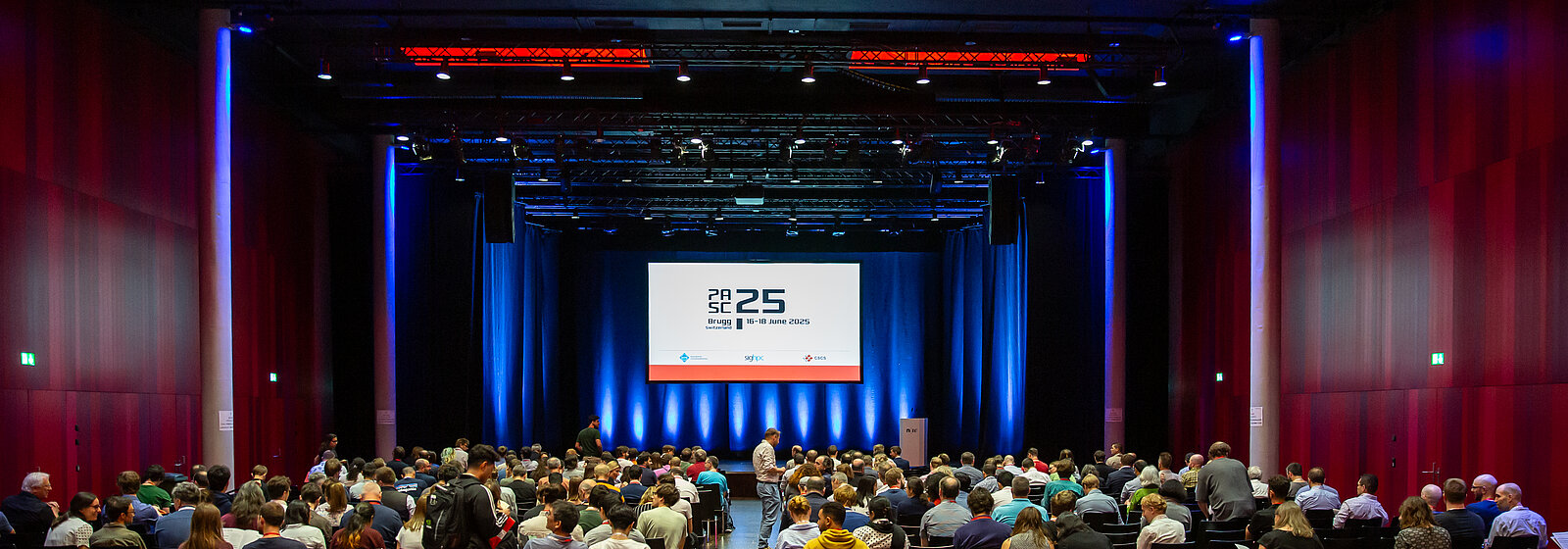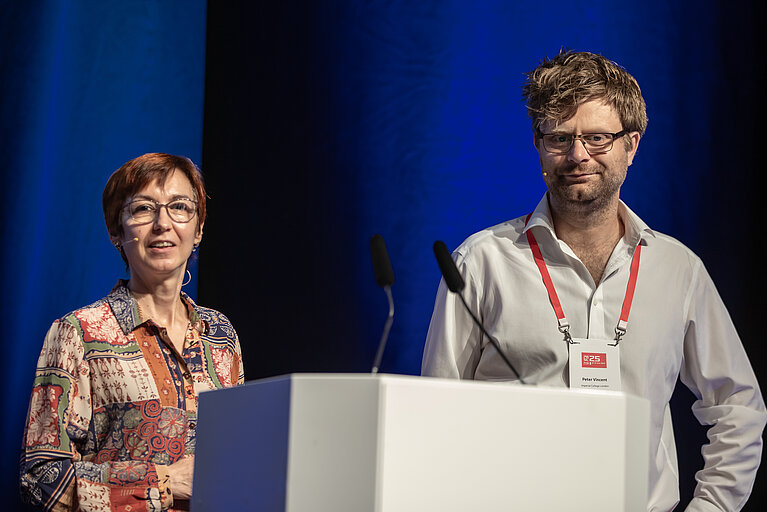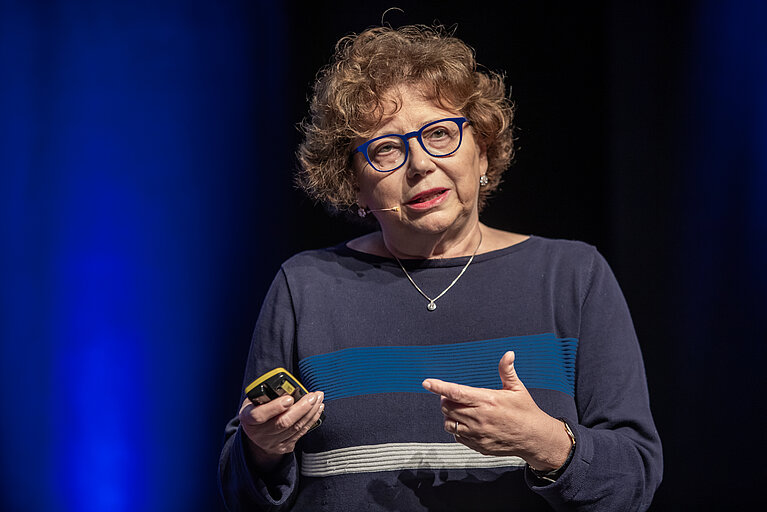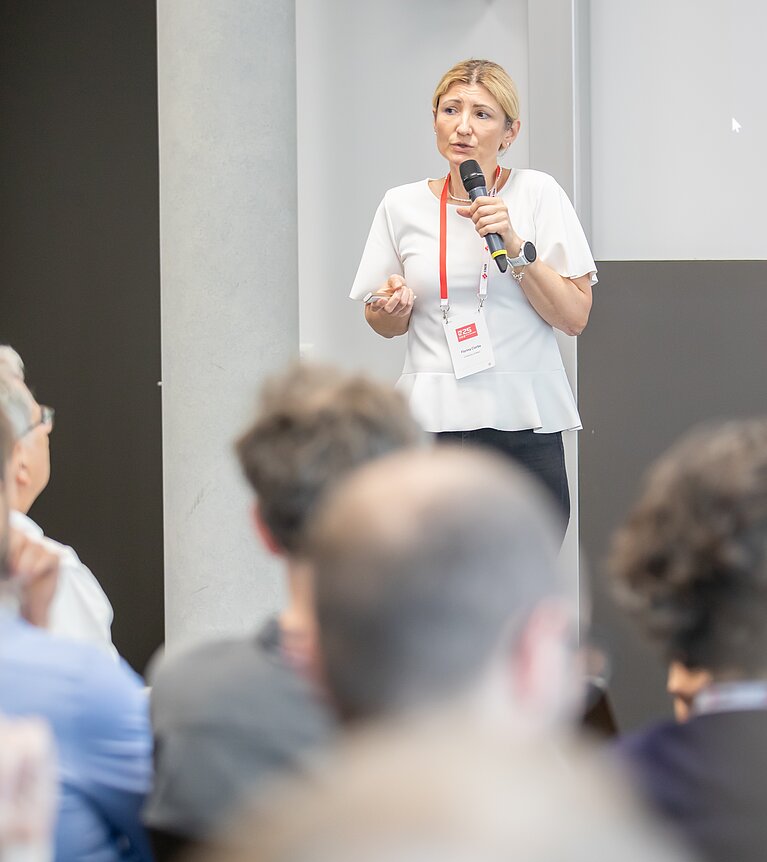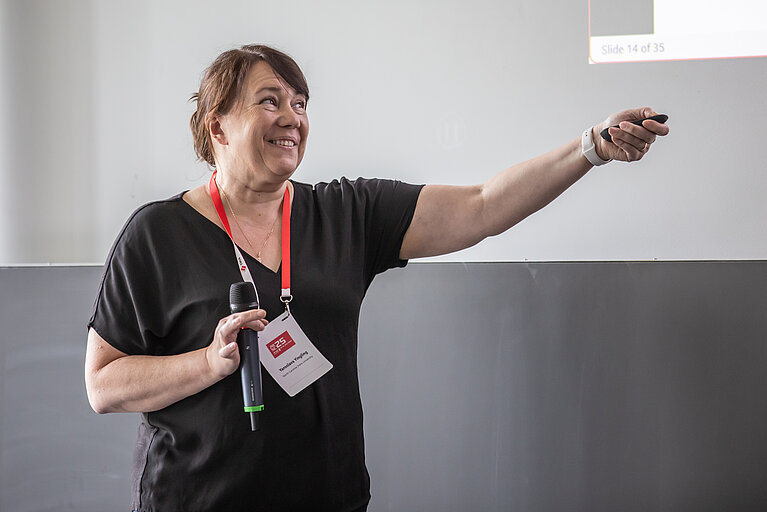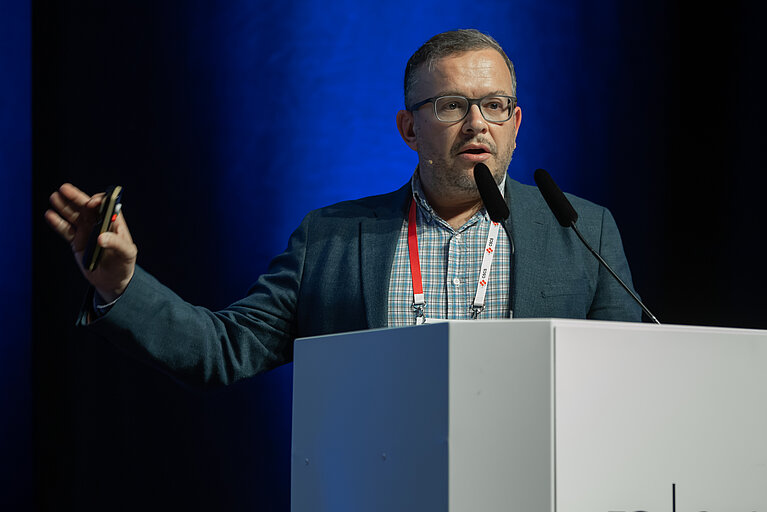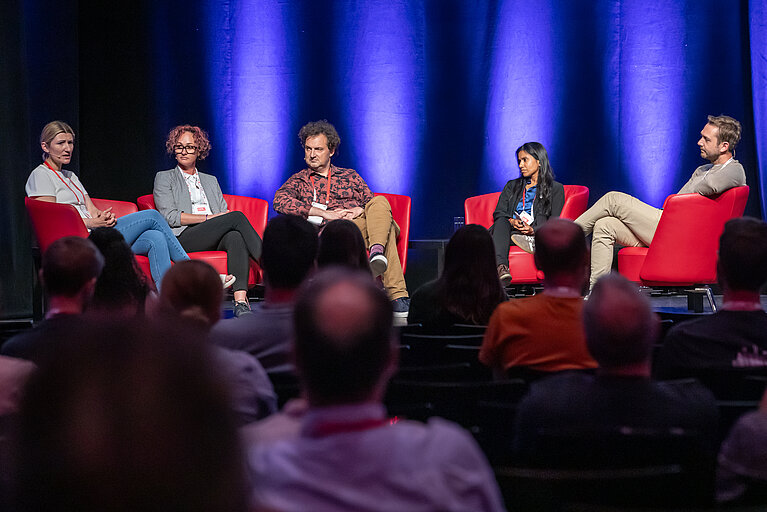July 3, 2025 – by Santina Russo
From June 16 to 18, 2025, the small Swiss town of Brugg hosted big questions—among them, how to reconcile the increasing demands of AI and high-performance computing (HPC) with the pressing need for sustainability. Held at the University of Applied Sciences and Arts Northwestern Switzerland, the PASC25 Conference gathered 414 participants from around the world to explore the conference’s timely theme: “Supercomputing for Sustainable Development.”
“The conference fully met our expectations,” said Laura Grigori, professor of applied and computational mathematics at EPFL and the Paul Scherrer Institute, who co-chaired the event alongside Peter Vincent, professor of computational fluid dynamics at Imperial College London. “We were really impressed by the response we got from the community. Almost every talk and minisymposium addressed how HPC can support sustainability—whether in more efficient drug design, renewable energy, reducing CO₂ emissions, or improving our understanding of climate change.”
Over 150 talks, 49 posters, and 18 published papers tackled the topic from multiple angles. While many focused on how supercomputers contribute to research aimed at helping achieve the United Nations’ Sustainable Development Goals (SDGs), the environmental footprint of supercomputing itself was also under scrutiny. “The positive impact of research made possible by supercomputers is one side of the scale,” Peter Vincent noted. “The other is the environmental cost of the supercomputers themselves. With the scale of data centres growing rapidly—especially due to AI—we must understand their power consumption and CO₂ emissions across their entire life cycle.”
In the opening keynote, Bronson Messer, Director of Science at Oak Ridge National Laboratory, showcased scientific problems that can only be tackled using supercomputers. For example, designing the landing process for a spacecraft descending onto the surface of Mars, where the atmosphere is 100 times less dense than Earth’s, cannot be tested in conventional labs—it requires complex simulations. Likewise, measuring turbulence and noise from large aircraft propellers is beyond the capacity of even the largest wind tunnels. Messer underscored how high-fidelity simulations are essential for scientific and engineering progress.
The second invited speaker of the conference, Elisa Molinari from CNR Nanoscience Institute, Italy, presented the effort of the European MaX project in streamlining and improving a set of material science simulation codes to make them both more accurate and more efficient—and thus more sustainable.
A focus on carbon emissions from supercomputing centres
Several speakers echoed the call for a better balance. In a minisymposium on sustainable computing for big data infrastructures, Florina Ciorba, professor of HPC at the University of Basel, presented figures illustrating the estimated carbon footprint of simulations run on supercomputers. One of her team’s codes for simulations in astrophysics and cosmology, SPH-EXA, was benchmarked across various machines.
A so-called hero run on LUMI, Europe’s supercomputing system in Finland, used the full machine for 12 hours and was estimated to have emitted CO₂ equivalent to 2.5 flights from New York to Melbourne. LUMI is carbon-neutral thanks to its use of hydroelectric energy. On Frontier at the Oak Ridge Leadership Computing Facility in Tennessee, a semi-carbon-neutral system, the same run would have produced emissions estimated at 7.2 flights. On CSCS’s new “Alps” supercomputer in Lugano, the group could perform four times as many simulations in the same period thanks to the machine’s efficient Grace Hopper 200 Superchips—while still keeping CO₂ output down to the equivalent of 2.3 flights, due to the Swiss grid’s reliance on low-carbon energy sources. In addition, CSCS’s uses a sustainable lakewater-based cooling system.
“In HPC, we’ve long chased performance while ignoring the environmental cost,” said Ciorba. “Projects don’t just have a computational cost—they have an environmental one, too. We need to view balancing performance, portability and sustainability as a necessity, not a luxury.” She urged researchers to include environmental metrics in their publications to build awareness. “If these metrics gain visibility, we can raise awareness and drive change,” she said.
Sustainability as a comprehensive concept
Other sessions addressed sustainability from the standpoint of software usability, accessibility, and visualisation of meaningful results for policymakers and the public. Paola Cinella, professor at Sorbonne University, for example, explored the challenge of making aviation more sustainable. Air traffic is projected to rise by up to 80 percent in the coming years, with long-haul flights contributing the lion’s share of emissions. “Small improvements won’t cut it—we need radical aircraft redesign,” she said. High-fidelity simulations of novel engine designs like open fan rotors are critical but come with a hefty carbon cost themselves. Here, machine learning offers a potential solution by accelerating simulations and allowing researchers to construct high-fidelity surrogate models that preserve accuracy at a much lower computational cost.
The role of AI in sustainability was further explored in a minisymposium presentation by Yaroslava Yingling, professor at North Carolina State University. Her group combined AI and molecular modelling to tackle phosphorus pollution in North Carolina’s Neuse River, which had caused massive fish deaths. Their model identified optimal locations to deploy newly designed nanomaterials for water cleaning—minimising both environmental impact and cost.
The conference’s public lecture, delivered by Alberto Figueroa, professor of surgery and biomechanical engineering at the University of Michigan, shifted the focus to personalised medicine. He presented how simulations help assist clinicians in treating coronary artery disease in ways tailored to individual patients. Figueroa also discussed the challenges of developing tools for clinical environments, where scientific rigour must meet safety and usability in patient care.
Sustainability was also the theme of this year’s best paper, presented by Katherine Arneson from the University of Illinois Urbana-Champaign. She pointed out that scientific software is often powerful, but not always usable. “It tends to overlook the needs of domain scientists,” she said—a reminder that human usability is part of sustainability too.
Awards at PASC25
The PASC Conference once again highlighted excellence in supercomputing and the diversity of talent within the community.
This year’s Best Paper Award at the PASC conference was presented to Katherine Arneson from the University of Illinois Urbana-Champaign for her work on improving the usability of scientific software.
In the ACM Student Research Competition, Patricia Honorato Moreira from Inteli (Institute of Technology and Leadership) in Brazil, received the award for best undergraduate poster. Among the graduate-level entries, first place went to Sonali Mayani from Paul Scherrer Institute, followed by Nicholas Cassarino from the University of North Carolina at Charlotte in second place and Merve Fedai from North Carolina State University in third.
The Best Poster Award went to the contributions of Carla Lopez Zurita from ETH Zurich and Emily Bourne from EPFL.
Notably, a majority of the awards were given to women researchers—a reflection of the diverse voices contributing to the advancement of HPC.
A healthy debate on the future of supercomputing
The conference’s themes came together in the final panel discussion on the last day, where experts debated the role of HPC in achieving the SDGs. Sally Ellingson from the University of Kentucky’s Markey Cancer Center emphasised that AI is already helping build digital twins in medicine, but “for truly personalised treatments, there’s still a long way to go.” James Hetherington of University College London recalled how supercomputers helped make life-saving decisions during the COVID pandemic and stressed the need for secure access to patient data.
The panel also explored the idea of “climate-aware” scheduling. Jobs that need more resources could be timed to coincide with cleaner energy availability—for instance, solar power in California during the day, unlike gas-dominated power during the night. Hetherington added that researchers have an obligation to write efficient code to limit resources and environmental cost.
As for the role of AI, opinions were nuanced. “AI is a powerful software accelerator,” said Florina Ciorba, “but it must be carefully integrated with HPC systems.” Ellingson emphasised that AI provides much potential to render simulations more efficient in many scientific branches, but that continuous validation is needed. Hindumathi Palanisamy of the World Meteorological Organization added a cautionary note: “HPC is crucial for climate science—but its environmental cost must not be ignored.”
As data volumes grow and computing power expands, the PASC25 conference made clear that the HPC community is not only working to support sustainable development—it is increasingly aware that its own practices must be sustainable, too. In the years ahead, this double focus is likely to define the future of supercomputing.
((Image credit: all photos by Marco Abram))
About PASC Conference
The Platform for Advanced Scientific Computing (PASC) Conference is an interdisciplinary conference in HPC that brings together domain science, applied mathematics, and computer science – where computer science is focused on enabling the realization of scientific computation. The PASC Conference provides three days of stimulating and thought-provoking sessions, including keynote presentations, minisymposia, peer-reviewed papers, panels, and poster sessions. The conference is co-sponsored by ACM SIGHPC, and full papers are published in the ACM Digital Library.
